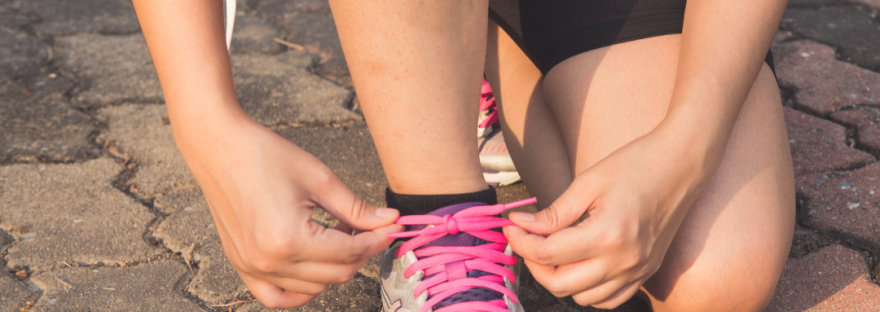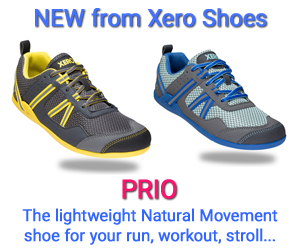I was a teenager the first time I experienced the pain of plantar fasciitis – that horrible pain in the arch and/or heel of the foot that makes the first steps out of bed absolutely excruciating. I went to a physical therapist and they utilized modalities like ultrasound and microcurrent, gave me very painful foot massage and stretching exercises and then recommended that I get custom orthotics for my shoes. My insurance did not cover custom orthotics, so my amazing mother shelled out $400 for a piece of hard plastic that truthfully, I only wore a few times. They were incredibly uncomfortable and did not fit into the shoes that I wanted to wear as a somewhat fashion-conscious teenager. When I moved out of my house for college, I found them stuffed away in the back of my closet and I felt so guilty that my mom had spent all of that money for nothing. Despite not wearing my orthotics and being very inconsistent with my exercises, my plantar fasciitis improved and I completely forgot about it.
A few years later I decided to start running everyday. I developed a SEVERE case of plantar fasciitis, but dealt with it for a few months because I was studying abroad in Australia and I didn’t know how to see a doctor or PT in a foreign country. By the time I got back to the US, the physical therapist said that it was one of the worst cases of plantar fasciitis that they had ever seen. Once again, I was advised to purchase expensive custom orthotics. I still felt guilty from my previous orthotic expense, so I vowed to wear these everyday and hopefully fix my plantar fasciitis for good.
As the years went by I continued to run and started purchasing my shoes from running stores, where they did a treadmill analysis to ensure that I was wearing the right shoe. They said that I definitely needed stability shoes along with my custom orthotics. For about 10 years I wore those custom orthotics and stability shoes and the pain in my feet was much less, but I could always tell when it was time to purchase new shoes because I would start getting foot pain again. This happened about every 8-10 months. By this time I had become a physical therapist and was standing for much of my workday. Everyone suggested Dansko shoes, which are very popular with many professions in which people are on their feet for long periods of time (like nursing). They were extremely comfortable and the optimum support shoes. I wore these for YEARS and I loved them.
Despite wearing all of these supportive shoes and custom orthotics, my calves became extremely tight and I couldn’t keep my heels down when I was walking uphill or up stairs due to this calf tightness. I couldn’t do a full squat because my ankles were so stiff. My knees started to hurt and I was developing glute weakness. It finally got to the point that I stopped running and started doing yoga (not just because of the pain, but that was a big reason). Yoga was difficult for a while because I was so tight everywhere, but the worst tightness was in my calves and ankles. During downward dog I was up on my tip toes and couldn’t get my heels anywhere close to the ground!
Then came COVID. How does COVID-19 have anything to do with this, you ask? I had to close my business for 9 weeks and only left my home a few times. Because of this, I walked around barefoot in my home far more than I ever had before. I only put on shoes to go on my daily walk, but besides that, I was shoeless, orthotic-less and support-less. And things started to change.
I was doing my normal yoga practice and suddenly my severe calf tightness was not as bad and I was finally able to see huge progress in my heel position during motions like downward dog. I was able to get farther down into a squat than I’d ever been able to do before. My balance with poses like Tree and Dancer were improving quickly. And my feet didn’t hurt! If anything, they felt better than ever before. Previously, if I had gone barefoot for any significant amount of time, I started getting heel and arch pain again, but this was not happening at all.
How curious…I really had to think about what had changed in my life that led to my flexibility, chronic foot pain and leg/glute weakness suddenly improving quicker than ever before, and in a very short period of time. I realized that whenever I put on my stability shoes for my daily walks, that my feet were being forced into a more duck-footed position and that I was walking on the outside of my feet. My shoes were starting to feel uncomfortable.
During COVID quarantine, I took the opportunity to do some continuing education. One of the presenters talked about the anatomical and biomechanical aspects of the feet and legs and how we are actually supposed to use them versus how many of us walk and stand today. It blew my mind! Everything he said we were built to do was the exact opposite of how I felt when I was wearing my supportive shoes and orthotics. But after a couple of months of walking barefoot, my body was naturally trying going back to this optimal alignment. How awesome is that???
**Some of the links below are affiliate links for Xero Shoes – I love them so much that I became an affiliate and hope to share their awesomeness with more people!
So I did a bunch of research on “barefoot” or “minimalist” shoes and found a local company that had styles that I liked. I will say, barefoot shoe styles are not really my jam, but the company I found really allowed me to find styles that work well for both professional and casual attire. And holy cow, I was amazed at how much more comfortable they were than my old shoes. These barefoot shoes have almost no padding at all, especially the dress shoes. You almost feel like your feet are directly on the ground with just a very thin sole that is just thick enough to protect your feet from any sharp or hazardous objects. Again, I could not believe how comfortable they were! I figured that by the end of the day, my feet would be crying out for support or cushion, but alas, my feet felt better than they ever had after standing all day! My calves didn’t feel tight at all, because there was no heel that shortened my calf muscles. My toes felt great because the toe boxes in barefoot shoes are very wide to allow your toes to splay they way that they are naturally meant to. This splay also allows your foot muscles, ligaments and joints to work in the way that they were built to do. A few weeks after wearing my dress shoes at work everyday, my feet felt better than they ever had, I had no back aching after standing all day and I felt grounded. The callouses on my feet were definitely forming much quicker because my feet were practically touching the ground now instead of being heavily protected, but that was the only side effect.
I wore the dress shoes for months, but wasn’t ready to make a full commitment to go “barefoot” with my walking shoes. I couldn’t imagine that I could walk 4 miles with a barefoot shoe and not have significant soreness and pain. So I opted for a zero-drop Brooks running shoe. It was great because my heels weren’t lifted and therefore my calves didn’t tighten as much, but they still squished the front of my foot and toes and had a very thick sole. Another few months went by and I was brave enough to try the Xero Shoes running/walking/hiking shoe (The Prio). I still can’t believe it – slipping them on, they felt like slippers and were the most comfortable shoes that I had ever worn. I had the same feelings that I did with my dress shoes, but these ones did have a little thicker sole to allow for outdoor adventures. I walked 4 miles and my body naturally increased my hip extension, which I have been trying to improve for a year! My glutes were actually working with each step, completely on their own!
The style of the barefoot/minimalist shoes has taken some getting used to, but at this point in my life, I don’t care, as long as I am allowing my body to work the way that it was meant to work. My husband has always called my style “functional” and I guess I’ve taken that to a whole new level now. But again, I’m not as worried about style as I am about being able to do activities better and with less injuries, and that is totally worth a change in my perception of how shoes “should” look.
I’m not sure that everyone will have the same experience, as our bodies have all been through different things over the years. I am ecstatic that I have found an answer to many of my chronic pains and tightness, and it was such an easy fix! If you have been wearing supportive shoes or orthotics for a long time and choose to try barefoot shoes, I would suggest weaning into it slowly. It took me about 9 months to make the full transition, and while I’m sure it could have been faster if I had been trying, it was a very smooth and seamless process that never resulted in pain, soreness or injury. Bodies adapt to whatever we put them through everyday, and if you’ve been “bracing” your feet for years with supportive shoes, they will take time to regain their strength and flexibility.
Also, there are certain conditions that would likely benefit from supportive shoes and orthotics, so make sure that you consult a physical therapist, pedorthist or podiatrist before you make any huge changes. Unfortunately, many people in these professions have been recommending orthotics and supportive shoes for so long that they might not be open to going “barefoot” or “minimalist.” This is when you have to listen to your body. Do a trial run of going barefoot in your house more often and see how you feel after a few weeks. If you tolerate it well after a few weeks, you can be more confident in making the transition to more minimalist shoes.
For further questions, or to schedule an appointment, please email Dr. Lisa Wilcox at DrLisa@SolsticePhysicalTherapy.com, call (720) 369-7738 or contact through her website at www.SolsticePhysicalTherapy.com.
**This is not to be considered medical advice, please contact a physical therapist or other healthcare professional for more information. All content on lisawilcoxpt.com is created for informational purposes only and is not to be taken as medical advice, treatment or diagnosis.


